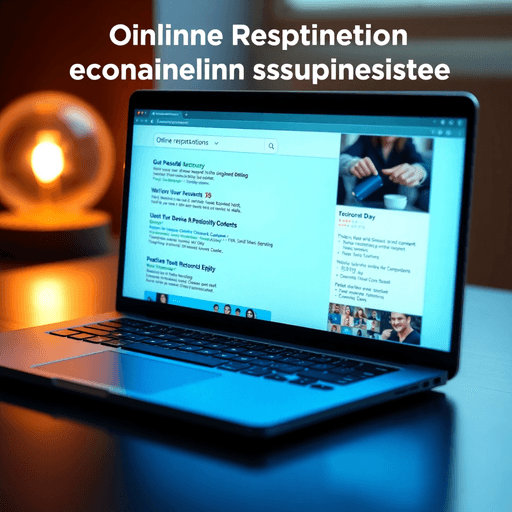Managing bad online reviews professionally is essential for any business operating in today’s digital landscape. A single negative review on Google, Yelp, or social media platforms can quickly influence public perception, impact your brand’s online identity, and directly affect your bottom line. Consumers rely heavily on the experiences of others when making purchasing decisions. If you neglect or mishandle negative feedback, potential customers may lose trust and turn to competitors.
Negative feedback handling isn’t just about damage control; it’s a strategic necessity. Unaddressed criticism can snowball into larger reputation issues, especially when harmful content appears prominently in search results. For instance, removing negative content from Google can significantly help in rebuilding your reputation. Businesses that prioritize effective online review management see increased customer loyalty and improved visibility in search engine rankings.
This article provides a practical roadmap for managing bad online reviews with confidence:
- Understanding the real impact of negative feedback on your brand
- Proven techniques for responding to reviews with professionalism
- Best practices for addressing criticism constructively
- Steps to create an internal policy for consistent online review management
- How to transform criticism into opportunities for brand growth
By implementing these strategies, you can protect your company’s reputation, build trust with your audience, and foster long-term success—even in the face of challenging feedback.
To further safeguard your online reputation, consider using online reputation monitoring tools which can help manage your image effectively. Moreover, understanding the benefits of reputation monitoring can provide insights into how proactive monitoring can safeguard your online reputation & alert you to risks early.
In case of severe reputation damage, it’s crucial to seek professional help through reputation repair services. These services offer effective strategies and tools to manage and repair your online reputation.
Lastly, mastering individual online reputation management strategies is also important for personal branding. Our guide on individual online reputation management strategies for success provides valuable insights on how to control your digital image effectively.
Understanding the Impact of Bad Online Reviews
Bad reviews can significantly harm a business’s reputation, leading to a decrease in customer trust and loyalty. When potential customers encounter negative feedback, they often perceive it as a reflection of the overall quality of your products or services. This perception can deter them from making a purchase, impacting your bottom line.
Key Points:
- Customer Trust: Negative reviews erode customer trust. When consumers see consistent negative feedback, they’re likely to question your business’s reliability and integrity.
- Loyalty: Existing customers may also be influenced by bad reviews. Their loyalty can waver if they believe the negative experiences shared by others could happen to them as well.
Consumers rely heavily on online reviews when making purchasing decisions. Studies show that a high number of negative reviews can discourage potential customers from engaging with your business. This reliance on reviews means that one bad review can have a ripple effect, influencing the opinions of countless potential clients.
Consider These Statistics:
- 95% of consumers read online reviews before making a purchase.
- 85% of people trust online reviews as much as personal recommendations.
- One negative review can cost you up to 22% of potential customers.
The negative impact extends beyond just losing individual sales. A tarnished reputation can lead to:
- Decreased Revenue: Potential customers may choose competitors over your business due to perceived risks.
- Brand Damage: Persistent negative feedback can harm your brand image, making it difficult to attract new customers.
- SEO Implications: Negative reviews can affect your search engine rankings, further reducing your visibility and reach.
Maintaining customer satisfaction is crucial for reputation protection. Addressing bad online reviews promptly and professionally shows that you value customer feedback and are committed to improving their experience. This proactive approach can mitigate the damage caused by negative reviews and help restore trust in your brand.
To combat the adverse effects of bad reviews, businesses should consider implementing effective strategies for business reputation management. This involves building, protecting, and restoring your online reputation with tailored strategies for a strong brand presence.
Additionally, focusing on boosting online credibility through positive reviews and engaging content can significantly enhance your brand trust. It’s essential to remember that consumers tend to compare 5-star reviews when choosing which business to engage with. Therefore, optimizing your online reputation for conversions should be a priority.
Moreover, mastering corporate reputation management is crucial in unlocking top talent and customer loyalty with strong reputation strategies. Learning from crisis management cases such as Chipotle or Uber could provide valuable insights into maintaining a robust corporate image.
Finally, employing strategic corporate communication strategies can further enhance brand reputation and drive business success in this digital age where online reviews hold significant power.
Responding to Reviews Effectively
A timely response to online reviews signals attentiveness and dedication to customer satisfaction. When you reply promptly—ideally within 24-48 hours—you reassure both the reviewer and potential clients that their feedback won’t go unnoticed. This practice not only helps contain negative sentiment but also demonstrates a proactive approach to service excellence.
Professionalism in every interaction is critical, regardless of the tone or accuracy of the review. Addressing all feedback, positive or negative, with courtesy sets your business apart as transparent and trustworthy. Even when faced with unfair criticism, maintaining composure shows maturity and respect for customers’ perspectives.
How to Acknowledge and Apologize
Acknowledgment is the foundation of any effective response. Begin by recognizing the customer’s experience:
“Thank you for sharing your feedback. We’re sorry to hear that your visit did not meet expectations.”
If you disagree with their perspective, avoid defensiveness. Instead, express empathy:
“We understand how disappointing it can be when an experience doesn’t go as planned. Your comments are important to us.”
A sincere apology can de-escalate frustration—even if you believe your business wasn’t at fault:
- Example:
“We apologize if our service did not meet your expectations. We strive for excellence and appreciate you bringing this to our attention.”
Offering Practical Solutions
The next step involves offering solutions or outlining actions you’ll take. Customers are far more likely to forgive mistakes when they see tangible efforts toward resolution.
- Invite the reviewer to continue the conversation privately, ensuring sensitive information is handled confidentially.
- Describe steps taken or planned improvements:
- “We’re reviewing our procedures with our staff to prevent this issue from happening again.”
- “Please contact us directly at [contact info] so we can make this right for you.”
By communicating clear next steps and following through, you create opportunities for dissatisfied customers to reconsider their opinions—and encourage onlookers to trust your commitment.
Maintaining this balance between quick acknowledgment, genuine apology, and practical resolution lays a strong foundation for effective review management. The focus shifts from damage control to relationship building, making each response a testament to your brand’s integrity.
Leveraging Positive Reviews
Don’t forget the power of positive reviews in shaping your online reputation. For instance, showcasing stellar reviews can build trust and drive more business success online. You can learn more about this in our article on 5-Star Review Examples & Tips.
Managing Negative Reviews
On the flip side, if a review is particularly damaging or inaccurate, it may be necessary to consider removing or altering your business listing from platforms like Google. This process can be complex but our guide on how to remove a business listing from Google provides step-by-step instructions to help safeguard your digital reputation.
Best Practices in Managing Bad Online Reviews
Customization of responses stands at the core of effective online review management. Each negative review carries its own context and set of concerns—generic, copy-paste replies communicate indifference and can make a business appear robotic or dismissive. Addressing specific complaints shows the reviewer (and anyone reading) that you have read their feedback carefully and take it seriously. For example:
“Thank you, Sarah, for letting us know about the delay in your order last Thursday. We understand how frustrating that must have been and are currently reviewing our shipping process to prevent this from happening again.”
This level of personalization not only validates the customer’s experience but also demonstrates real engagement.
Maintaining a polite and non-personal tone is equally essential, especially when faced with reviews that feel harsh or unfair. Responding defensively or emotionally often escalates the situation and may discourage potential customers who see your reply. Keep your language professional, avoid assigning blame, and thank the reviewer for their input—even if you disagree with their version of events. Some best practices include:
- Using “we” statements rather than “you” statements
- Avoiding direct confrontation or arguments
- Expressing appreciation for feedback regardless of tone
Viewing negative feedback as an opportunity shifts your mindset from damage control to long-term improvement. Every critical review is a chance to identify weaknesses in products, services, or processes. Businesses that act on this feedback stand out as proactive and customer-focused.
Taking action based on feedback means following up internally after each complaint—whether it’s retraining staff, updating policies, or refining service delivery. Customers notice when businesses implement visible changes in response to reviews; this transparency builds trust and encourages future positive engagement.
Moreover, it’s important to remember that managing bad online reviews is not just about responding to individual complaints but also about mastering your overall online reputation. A strong digital reputation is crucial for success as it attracts talent, boosts market value, and enhances customer perception.
By focusing on customization of responses, maintaining professional tone, taking real action based on feedback, and mastering your online reputation, you position your business as attentive, reliable, and committed to continuous growth—key qualities consumers look for when choosing where to spend their money.
Creating an Internal Policy for Online Review Management
Every business benefits from a clear, actionable internal policy for online review management. This framework ensures consistency across teams and supports a unified brand voice—especially when handling sensitive feedback.
Core Elements of a Review Management Policy
1. Language and Tone Guidelines
- Define the tone to match your brand’s values: professional, empathetic, and solution-oriented.
- Outline specific language to avoid—such as blaming or defensive phrases—in all responses.
- Provide sample scripts for different scenarios (complaints, suggestions, praise) while encouraging customization.
- Set ground rules for engaging with inflammatory or abusive reviews, ensuring responses remain calm and respectful.
2. Response Time Standards
- Establish response benchmarks based on industry standards. For example:
- 24 hours for negative or urgent reviews
- 48 hours for neutral or positive feedback
- Assign responsibility so each review receives timely acknowledgment.
- Use tools like Google Alerts or specialized monitoring software to track new mentions and reviews in real-time.
3. Escalation Procedures
- Identify which types of reviews require higher-level intervention. For instance:
- Allegations of illegal activity
- Threats of legal action
- Persistent or high-profile customer dissatisfaction
- Map out a clear escalation path—from frontline staff to senior management or legal counsel.
- Document each step taken during escalation to maintain transparency and accountability.
Building an Effective Policy
Involve key team members from customer service, marketing, and legal departments in policy creation.
Train staff regularly to reinforce guidelines and adapt to evolving best practices.
Review policies quarterly to update language, adjust response time standards, or refine escalation procedures based on recent experiences.
A strong internal policy safeguards brand integrity while empowering employees to handle negative feedback with confidence and professionalism. Clear guidance reduces uncertainty during stressful situations and keeps the business aligned with its reputation goals.
Transparent processes also position your team to turn challenging reviews into opportunities—a concept explored in the following section.
However, despite best efforts, there may be instances where immediate action is required for damage control. This is where fast reputation repair strategies come into play. These expert strategies allow businesses to swiftly revamp their online presence.
In some cases, it may be necessary to remove harmful online content. This process can safeguard your reputation significantly. Additionally, employing SEO reputation management services can further enhance your online reputation by promoting positive content effectively.
For those looking to manage their online reviews independently, there are several DIY online reputation management tips available that provide expert-backed guidance on handling negative feedback effectively.
Turning Negative Reviews into Opportunities for Brand Enhancement
Transparency and professionalism are not just damage-control strategies—they are active drivers of positive brand perception. Every negative review is a public test of your company’s values, integrity, and willingness to listen. When you approach criticism with openness, you signal that your business has nothing to hide and welcomes honest feedback. This practice builds trust with existing customers and attracts new ones who value authenticity.
Key strategies for leveraging negative reviews:
-
Publicly Acknowledge Mistakes: Clearly admit when an error has occurred. Avoid shifting blame or making excuses. Customers appreciate straightforward communication, which reflects confidence in your brand.
“Thank you for bringing this to our attention. We recognize that our service fell short of expectations during your visit, and we’re committed to making it right.”
-
Respond with Professionalism: Regardless of the reviewer’s tone, maintain a calm, respectful voice in every reply. Professional responses demonstrate leadership and reinforce a positive company culture. This is where effective public relations strategies come into play.
-
Showcase Commitment to Customer Care: Offer actionable solutions or compensations where appropriate. Share specific steps being taken to resolve the issue, such as retraining staff or updating processes.
“We are implementing additional training for our team based on your feedback, so future experiences reflect our high standards.”
-
Encourage Follow-Up: Invite dissatisfied reviewers to continue the conversation offline. Provide direct contact details for swift resolution, showing personal investment in their satisfaction.
Highlighting these actions publicly transforms negative reviews from liabilities into compelling proof points for your dedication to improvement and customer well-being.
A focus on commitment to customer care must be visible across all digital platforms—Google reviews, social media comments, third-party review sites. Timely engagement assures both current customers and potential leads that their voices matter.
When handled with transparency and professionalism, negative feedback becomes a springboard for strengthening credibility and reinforcing brand values. Businesses that consistently demonstrate this commitment often see improved customer loyalty and increased positive word-of-mouth—critical assets in today’s digital marketplace.
Moreover, it’s essential to understand the importance of brand image in marketing. A strong brand image can significantly boost reputation, attract top talent, and drive customer loyalty.
In some cases, however, negative content might persist online despite best efforts. In such instances, utilizing expert content removal services can be beneficial in eliminating negative posts and protecting your online reputation swiftly.
Ultimately, turning negative reviews into opportunities requires a strategic approach that not only addresses the immediate concerns but also reinforces the overall brand image through storytelling strategies that build emotional connections and foster trust—an integral aspect of creating a positive brand image as discussed in this resource on creating a positive brand image.
Conclusion
Managing bad online reviews professionally is crucial for long-term business success. Protecting your reputation online and enhancing brand credibility can significantly impact customer trust and loyalty. Implementing the strategies discussed in this article, such as responding promptly, customizing responses, and viewing negative feedback as growth opportunities, can help you manage bad online reviews effectively.
For businesses seeking more personalized assistance, professional help is available. You can reach out for expert guidance in developing a tailored online review management plan that aligns with your specific goals and industry standards. This could*Business Reputation Management* approach can include removing negative content from platforms such as Google through a comprehensive Google Business Profile Removal Guide, or learning how to delete your business from Google Maps to maintain brand integrity.
Moreover, by mastering crisis management techniques through our resources on Crisis Management for PR Success, you can protect your brand and maintain its reputation during tough times. Additionally, understanding*Mastering Value Propositions for Brand Success* will set your brand apart and attract loyal customers effortlessly.
By taking proactive steps and utilizing the right resources, you can turn negative reviews into opportunities for improvement and brand enhancement.






